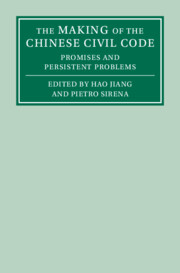Book contents
- The Making of the Chinese Civil Code
- The Making of the Chinese Civil Code
- Copyright page
- Dedication
- Contents
- Tables
- Contributors
- Preface
- Acknowledgements
- Abbreviations
- 1 The Making of a Civil Code in China
- 2 Personality Rights in China’s New Civil Code
- 3 Force Majeure or Change of Circumstances
- 4 Article 580 (2) of the Chinese Civil Code
- 5 Contractual Consent in the New Chinese Civil Code
- 6 The Security Interests in Chinese Law
- 7 Chinese Tort Law in the Era of the Civil Code
- 8 Causation in the Chinese Civil Code
- 9 The Aims of Tort Law across China and the West
- 10 Classifying the Passive Appreciation of Separate Property during Marriage in the Chinese Civil Code
- 11 The Rule of Law in Traditional China
- 12 The Private Law Influence of the Great Qing Code
- 13 The New Validity Rules in Chinese Civil Code and Chinese State-Owned Enterprises’ Freedom in Contracting
- 14 Chinese Civil Law and Soviet Influences
- 15 The Connections between Roman Law and Chinese Civil Law
- Index
14 - Chinese Civil Law and Soviet Influences
What Is Left?
Published online by Cambridge University Press: 31 August 2023
- The Making of the Chinese Civil Code
- The Making of the Chinese Civil Code
- Copyright page
- Dedication
- Contents
- Tables
- Contributors
- Preface
- Acknowledgements
- Abbreviations
- 1 The Making of a Civil Code in China
- 2 Personality Rights in China’s New Civil Code
- 3 Force Majeure or Change of Circumstances
- 4 Article 580 (2) of the Chinese Civil Code
- 5 Contractual Consent in the New Chinese Civil Code
- 6 The Security Interests in Chinese Law
- 7 Chinese Tort Law in the Era of the Civil Code
- 8 Causation in the Chinese Civil Code
- 9 The Aims of Tort Law across China and the West
- 10 Classifying the Passive Appreciation of Separate Property during Marriage in the Chinese Civil Code
- 11 The Rule of Law in Traditional China
- 12 The Private Law Influence of the Great Qing Code
- 13 The New Validity Rules in Chinese Civil Code and Chinese State-Owned Enterprises’ Freedom in Contracting
- 14 Chinese Civil Law and Soviet Influences
- 15 The Connections between Roman Law and Chinese Civil Law
- Index
Summary
China’s Civil Code (民法典), promulgated by the National People’s Congress on 28 May 2020, took effect on 1 January 2021 and has since replaced the previous relevant legal principles embodied in various sources of civil law. Its seventh Book on Tort Liability (侵权责任) codifies the new version of Chinese tort law and has replaced the Tort Liability Law made by the Standing Committee of the National People’s Congress in 2009. On the one hand, the Book on Tort Liability follows to a large extent its predecessor in terms of the structure and content; on the other hand, it has introduced some substantive revisions. This chapter focuses on Chinese tort law in the era of the Civil Code. It examines three major revisions that the Civil Code brings to Chinese tort law, including redefining the concept of “tort liability”, expanding the application of punitive damages, and refining the rules of cybertort liability. It then analyses features of Chinese tort law codified in the Civil Code, specifically regarding the compensation system, the imputation system, and the multi-tier liability system. It finally discusses the approaches to developing Chinese tort law in the era of the Civil Code.
- Type
- Chapter
- Information
- The Making of the Chinese Civil CodePromises and Persistent Problems, pp. 292 - 307Publisher: Cambridge University PressPrint publication year: 2023



